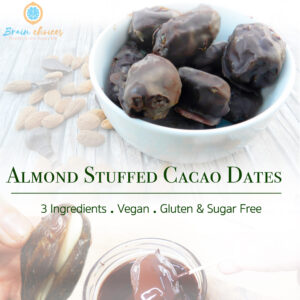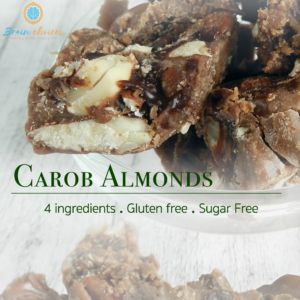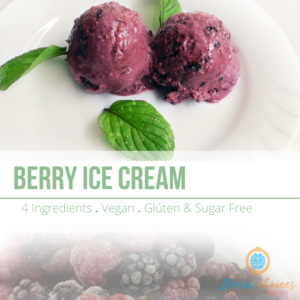
This seasonal fall salad is delicious, plus is high in antioxidants and other disease-fighting nutrients.
You have probably already heard the phrase “eat the rainbow”, which means eating foods of several colors. Why? Because different colors mean different phytonutrients. As a general rule, the more intense the color, the better. It means this veggie/fruit is packed with flavonoids.
Why is this recipe good for your brain?
Let’s look at some of the ingredients in this salad and why they are beneficial for our brain.
First of all, this salad is packed with flavonoids! And what are flavonoids, you might be asking?
Flavonoids are plant compounds present in fruits, vegetables, grains, legumes, nuts, and tea. They have several health benefits compounds, including antioxidant and anti-inflammatory activity. Several studies have shown that flavonoid-rich foods like fruits and vegetables may protect against chronic diseases [1].
When it comes to the brain, flavonoids may help in preventing premature aging and deterioration of brain function. In fact, several studies observed that people who consumed the highest amount of flavonoids long-term (for about 20 years) had a lower risk of developing Alzheimer’s disease and other dementias [2-4]. A very recent study followed over 77,300 people for about 18 years [3]. They observed that a higher intake of flavonoids was associated with a lower risk of cognitive decline. Thus, these studies clearly show the importance of a high flavonoid intake for maintaining a good brain function.
As I have already mentioned in my articles several times, dark green leafy vegetables are packed with important nutrients for our brain, and they have been actually shown to reduce brain aging by 11 years! And very honestly, lamb’s lettuce is one of my favorite dark green leaves. It tastes great and it’s super rich in nutrients!
Beets are another of my favorite “brain foods”. They contain nitrates, which are converted into nitric oxide in the blood, which helps widen and relax blood vessels. This helps improve blood flow to the brain, which in turn may slow cognitive decline [5, 6]. Besides the benefits for the brain, beetroot has also shown to improve exercise performance, reduce blood pressure and improve cardiovascular health [7-9]. In addition, beets are also rich in potassium, which is an important mineral for our nerve cells.
Pumpkin seeds are a good source of magnesium and zinc, which are two minerals essential for proper brain function. Low magnesium and zinc levels have been linked to several neurological and psychiatric diseases [10-12].
Walnuts contain several components (including plant omega-3s) that have antioxidant and anti-inflammatory effects. Several studies suggest that eating walnuts regularly may improve memory and learning, and reduce the risk and or progression of mild cognitive impairment and Alzheimer’s disease [13].
Wild salmon is a very good source of the omega-3 DHA (docosahexaenoic acid), which our brain requires to many processes, such as neuronal survival, synaptogenesis formation of new synapses (i.e. connections between neurons), neuroplasticity and to prevent brain inflammation. DHA deficiency in the brain has been noted in several brain and mental disorders and a higher intake may prevent them. For example, in a review of 20 observational studies, 17 reported a link between a higher intake of omega-3s and a reduced risk of Alzheimer’s [14]. Wild salmon also contains another omega-3, EPA (eicosapentaenoic acid), which studies show may have beneficial effects on depression. This may have to do with the anti-inflammatory effects of EPA [15].
So, let’s go now to the recipe of this delicious and healthy salad 😊
Flavonoid-rich fall salad
Ingredients
For the pumpkin
- 1/2 small pumpkin
- 1/2 tsp paprika powder
- 1 tsp curry powder
- sea or Himalaya salt to taste
For the salad
- 2 handfuls lamb's lettuce
- 1 small beet, thinly sliced
- 1/2 avocado, cut into cubes
- 1 handful walnuts
- 1 tbsp pumpkin seeds
- 1/2 pomegranate
- 120 g wild salmon
For the salad dressing
- 2 tbsp extra-virgin olive oil
- 1 tbsp apple cider vinegar
- Sea or Himalaya salt to taste
- Optional: 1 tsp Dijon mustard (without sugar)
Instructions
- Preheat the oven to 170°C.
- Cut the pumpkin into small cubes and add it to a baking tray.
- Add the spices to the pumpkin and stir.
- Bake the pumpkin for about 40 min or until soft.*
- Meanwhile, steam the salmon using a little bit of water for about 5-10min (you can also put it in the oven for about 12 min together with the pumpkin – but remember to take it out!)
- Prepare the salad: add the lamb’s lettuce to a bowl, and then all the other ingredients.
- Prepare the salad dressing by mixing all ingredients.
- When the salmon and pumpkin and ready, add them to the bowl.
Notes
Do you also enjoy salads in autumn? Which ingredients do you use?
Let me know in the comments below! 🙂
P.S. – If you like my articles, please be sure to subscribe to my free newsletter to receive my new content directly in your inbox!
References
- Waheed Janabi, A.H., et al., Flavonoid-rich foods (FRF): A promising nutraceutical approach against lifespan-shortening diseases. Iran J Basic Med Sci, 2020. 23(2): p. 140-153.
- Shishtar, E., et al., Long-term dietary flavonoid intake and risk of Alzheimer disease and related dementias in the Framingham Offspring Cohort. Am J Clin Nutr, 2020. 112(2): p. 343-353.
- Yeh, T.S., et al., Long-term Dietary Flavonoid Intake and Subjective Cognitive Decline in US Men and Women. Neurology, 2021. 97(10): p. e1041-e1056.
- Lefevre-Arbogast, S., et al., Pattern of polyphenol intake and the long-term risk of dementia in older persons. Neurology, 2018. 90(22): p. e1979-e1988.
- Presley, T.D., et al., Acute effect of a high nitrate diet on brain perfusion in older adults. Nitric Oxide, 2011. 24(1): p. 34-42.
- Wightman, E.L., et al., Dietary nitrate modulates cerebral blood flow parameters and cognitive performance in humans: A double-blind, placebo-controlled, crossover investigation. Physiol Behav, 2015. 149: p. 149-58.
- Coggan, A.R., et al., Acute Dietary Nitrate Intake Improves Muscle Contractile Function in Patients With Heart Failure: A Double-Blind, Placebo-Controlled, Randomized Trial. Circ Heart Fail, 2015. 8(5): p. 914-20.
- Bonilla Ocampo, D.A., et al., Dietary Nitrate from Beetroot Juice for Hypertension: A Systematic Review. Biomolecules, 2018. 8(4).
- Dominguez, R., et al., Effects of beetroot juice supplementation on intermittent high-intensity exercise efforts. J Int Soc Sports Nutr, 2018. 15: p. 2.
- Portbury, S.D. and P.A. Adlard, Zinc Signal in Brain Diseases. Int J Mol Sci, 2017. 18(12).
- Petrilli, M.A., et al., The Emerging Role for Zinc in Depression and Psychosis. Front Pharmacol, 2017. 8: p. 414.
- Kirkland, A.E., G.L. Sarlo, and K.F. Holton, The Role of Magnesium in Neurological Disorders. Nutrients, 2018. 10(6).
- Chauhan, A. and V. Chauhan, Beneficial Effects of Walnuts on Cognition and Brain Health. Nutrients, 2020. 12(2).
- Yanai, H., Effects of N-3 Polyunsaturated Fatty Acids on Dementia. J Clin Med Res, 2017. 9(1): p. 1-9.
- Liao, Y., et al., Efficacy of omega-3 PUFAs in depression: A meta-analysis. Transl Psychiatry, 2019. 9(1): p. 190.




